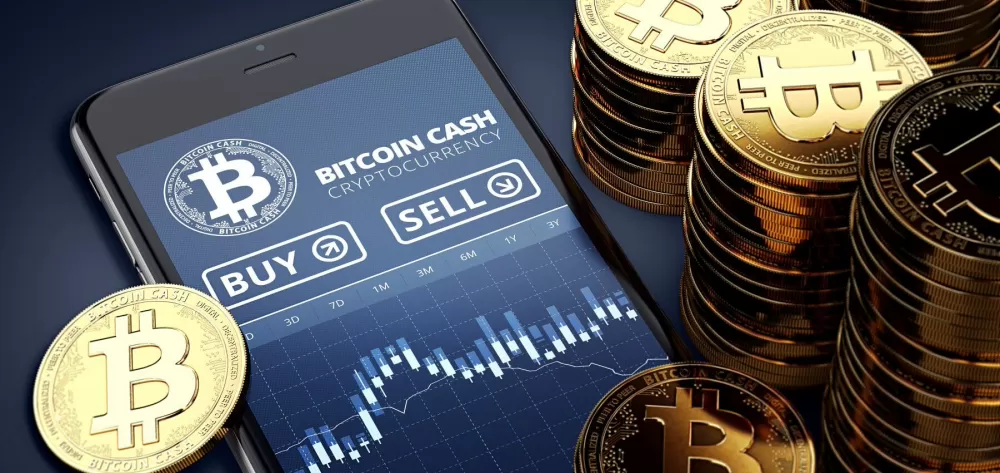From alternative currencies to meme coins, cryptocurrencies have rapidly gained popularity in Switzerland. A lot of this attention is focused on the prices of bitcoin and altcoins, with hypes being generated when these virtual currencies reach new highs against the Swiss franc or drastically lose in value.
But which factors have a particularly strong impact on cryptocurrency prices? Find out in this overview from moneyland.ch.
Whether or not a cryptocurrency can even be priced depends on whether it can be exchanged for Swiss francs or other currencies. The number of options available for exchanging or trading a cryptocurrency also affects its price. Cryptocurrencies and tokens which are new or are not widely adopted are particularly affected.
When a major cryptocurrency exchange decides to list a cryptocurrency, this action signals that the cryptocurrency has a broad following. At the same time, a listing on an exchange makes a cryptocurrency available to many more people, increasing potential demand. In many cases, trading a cryptocurrency often becomes cheaper when big exchanges begin listing it.
For all of these reasons, the prices of cryptocurrencies often go up when a major platform decides to list it. That is especially the case if there is already demand which has not been filled by existing options. For example, if a cryptocurrency was not previously available in a certain region, or could only be obtained with great difficulty, its value may rise when it becomes available in that region. For the same reason, prices can rise when a renowned financial services provider offers a cryptocurrency to the masses in an uncomplicated way – for example in the form of an exchange-traded fund (ETF).
Hype plays a major role in influencing cryptocurrency demand. This is particularly true for meme coins, which offer little or no value other than emotional drivers which have the potential to create a hype. When a cryptocurrency hype occurs, coins are bought in huge quantities because everybody is talking about them. The increased demand pushes the price upwards.
Because some cryptocurrencies – particularly bitcoin – have repeatedly made headlines with major price hikes, speculators often interpret climbing price rates as a sign that prices will get even higher in the future. Because of this, a spike in the price of a cryptocurrency often triggers even more hype. This leads to even more demand which, in turn, pushes the price up further.
The risk of hypes is that investors who bought earlier on at lower prices will use the opportunity provided by the hype to sell their coins for a profit. When this happens, the price can fall very quickly. So hype has a strong influence on price developments, but it is no clear indicator that prices will continue climbing.
A hype can be triggered by bigger investors or “whales” buying large quantities of a cryptocurrency. After car manufacturer Tesla announced that it had purchased 1.5 billion US dollars’ worth of bitcoin in 2021, the price of bitcoin skyrocketed to record highs. On the flip side, the price of a cryptocurrency can quickly drop when a whale sells it in large quantities.
Cryptocurrencies are largely dependent on private service providers which provide opportunities to buy, sell, invest, and spend them. Resultingly, events affecting service providers can hugely impact cryptocurrency prices.
The infamous Mt. Gox hack is an early example of how a company’s development can impact crypto prices. In 2013, the Mt. Gox exchange handled around 70 percent of bitcoin transactions. However, hackers had found a way to steal 800,000 bitcoins held by Mt. Gox. When the trading platform went bankrupt after the theft was revealed in 2014, the price of bitcoin fell by nearly one-third over the short term. Previously, rumors surrounding Mt. Gox had already resulted in a number of bitcoin price corrections.
On the other hand, events related to service providers can also drive prices up. For example, the price of bitcoin reached all-time highs after the Chicago Mercantile Exchange group announced the launch of bitcoin futures in 2017. The prices of bitcoin also reached new records when cryptocurrency exchange operator Coinbase went public in 2021. In early 2024, the launch of Bitcoin ETFs in the US contributed to record-high crypto prices.
Short-term hype is not enough to maintain the price of a cryptocurrency. Over the longer term, the value of a cryptocurrency partially depends on the size and engagement of the community which backs it. Meme coins, in particular, have been able to hold and even grow their value solely because they have engaged fan communities which drive interest in them.
In the case of cryptocurrencies which aim to deliver technological value, developer communities play a significant role. For example, when prominent bitcoin developer Mike Hearn announced the end of his involvement in the bitcoin project in 2016, the price of bitcoin fell by 10 percent. Hearn had published a blog post in which he stated his opinion that the bitcoin experiment had failed.
If a cryptocurrency to be more than an object of speculation, then possible uses are not enough – it must also become widely accepted as a currency. A cryptocurrency like bitcoin could theoretically be an alternative to fiat currencies like the Swiss francs or the US dollar. But for that to happen, it must become accepted by stores, online shops, and other points of sale.
The more merchants and individuals accept a cryptocurrency, the more value it has because the chance of it being widely adopted is higher. If acceptance of a cryptocurrency increases, demand for it is also likely to increase.
Acceptance is not necessarily limited to conventional, everyday financial transactions. If, for example, a non-fungible token (NFT) were to become established as the standard for digital art, the price of its corresponding cryptocurrency would likely go up.
The price of a product or service is determined by supply in relation to demand. Each cryptocurrency has its own rules governing how many coins or tokens are available, and the ongoing supply of new coins. Because of this, the impact of supply on prices varies between cryptocurrencies.
Bitcoin, for example, has a clear limit on the maximum number of coins which can be generated. The amount of bitcoin generated to reward a network participant for processing a transaction (mining) is halved every four years. This reduces the supply of new bitcoins into the market. The price of bitcoin and cryptocurrencies with similar rules may climb when this kind of halving occurs. But there are also cryptocurrencies which have very high limits on the maximum number of coins which can be created, or have no limit at all.
Reduction in the supply through “burning” is another factor which can significantly impact a cryptocurrency’s price. Burning occurs when a party which holds a notable amount of a cryptocurrency transfers a given number of coins to a wallet which cannot be accessed by anyone – not even its original owner. This effectively removes the “burned” coins from circulation, and from the total supply. The price of a cryptocurrency may rise when a trusted person or other entity announces that they have burned a significant portion of the total supply.
Blockchain technology is relatively new, and is developing at a rapid pace. Technological improvements can result in cryptocurrencies becoming more widely accepted, which may convince more investors to buy it.
But technological developments can also bring uncertainty. So-called forks are one example. During a fork, a cryptocurrency is duplicated to create a new cryptocurrency – typically with different features to the first. This usually happens when developers want to make significant technological changes to an existing cryptocurrency.
Forks generally lead to heightened insecurity, as well as debates within communities. Investors may try to profit from upcoming forks using various tactics. These factors normally result in increased price volatility when a fork occurs.
Many cryptocurrencies are very similar to each other, or target the same niche markets or use cases. This means that they are in competition with each other. Additionally, cryptocurrencies may also compete with fiat currencies.
Competition has a direct impact on the prices of cryptocurrencies. For example, there is a chance that a new cryptocurrency could be developed which is more technologically advanced than current leaders like bitcoin and Ethereum. If technological advances allow new blockchains to perform the same tasks better or more efficiently, even leading cryptocurrencies could decline in popularity, and their prices may decline with it. The price of the new, competing cryptocurrency, on the other hand, would likely shoot up.
The way in which fiat currencies develop also plays a role. Prices of cryptocurrencies designed to be used for payments are particularly prone to adjustments in inflation and deflation. Some investors see cryptocurrencies as a good solution for hedging against inflation. The assumption is that because decentralized currencies are not tied to one economy or central bank, their real value should theoretically remain stable even during periods of heavy inflation or deflation.
There has even been some speculation that cryptocurrencies – and bitcoin in particular – could provide a similar hedge against inflation as gold does. However, it is unclear whether this will really be possible in the long term.
Cryptocurrencies, as a relatively new investment vehicle, are not yet as heavily regulated as other financial instruments. The result is that there are fewer limitations on speculation, which can mean higher volatility. It is likely that more regulations will be put in place, in which case cryptocurrency prices may become less volatile.
But legal regulations themselves can also impact prices. For example, the price of bitcoin fell in 2021 when China’s central bank announced that cryptocurrency transactions would be regarded as illegal.
On the other hand, decisions to regulate rather than ban cryptocurrencies can result in the creation of more cryptocurrency-based products for institutional investors – such as new ETFs. Demand for these products can, in turn, boost cryptocurrency prices.
- Political and economic insecurity
From US presidential elections to global pandemics or looming civil wars, political unrest or economic insecurity can trigger fears of losing wealth. These fears influence the behavior of investors. Those who see cryptocurrencies as stable and inflation-resistant assets may turn to them in hope of protecting their wealth. The resulting demand can push prices up.
However, the opposite is usually the case: Investors withdraw from risky investments in uncertain times. As cryptocurrencies are often considered particularly risky, prices fall accordingly.
More on this topic:
Compare Swiss online trading platforms now
How to buy and spend bitcoin in Switzerland
Shiba Inu: The facts behind the hype
Calculate bitcoin investments now
Popular cryptocurrencies compared





